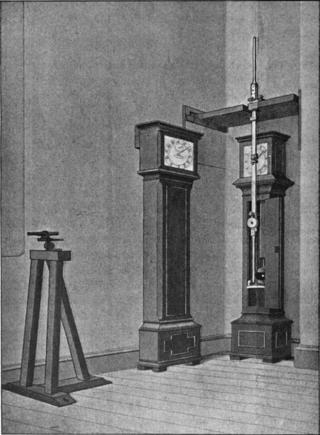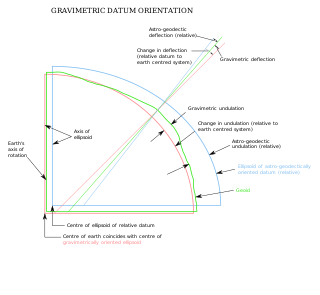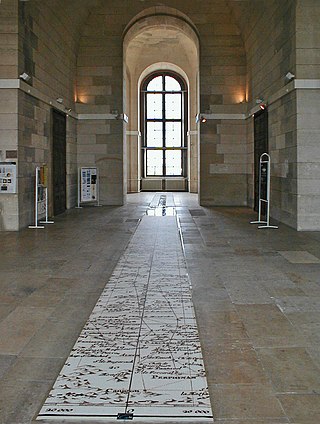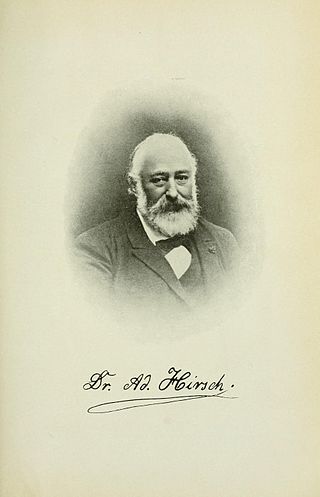
Geodesy is the science of measuring and representing the geometry, gravity, and spatial orientation of the Earth in temporally varying 3D. It is called planetary geodesy when studying other astronomical bodies, such as planets or circumplanetary systems.

The metre is the base unit of length in the International System of Units (SI). Since 2019 the metre has been defined as the length of the path travelled by light in vacuum during a time interval of 1/299792458 of a second, where the second is defined by a hyperfine transition frequency of caesium.

A Kater's pendulum is a reversible free swinging pendulum invented by British physicist and army captain Henry Kater in 1817 for use as a gravimeter instrument to measure the local acceleration of gravity. Its advantage is that, unlike previous pendulum gravimeters, the pendulum's centre of gravity and center of oscillation do not have to be determined, allowing a greater accuracy. For about a century, until the 1930s, Kater's pendulum and its various refinements remained the standard method for measuring the strength of the Earth's gravity during geodetic surveys. It is now used only for demonstrating pendulum principles.

The history of geodesy (/dʒiːˈɒdɪsi/) began during antiquity and ultimately blossomed during the Age of Enlightenment.

In geodesy, the figure of the Earth is the size and shape used to model planet Earth. The kind of figure depends on application, including the precision needed for the model. A spherical Earth is a well-known historical approximation that is satisfactory for geography, astronomy and many other purposes. Several models with greater accuracy have been developed so that coordinate systems can serve the precise needs of navigation, surveying, cadastre, land use, and various other concerns.

In satellite laser ranging (SLR) a global network of observation stations measures the round trip time of flight of ultrashort pulses of light to satellites equipped with retroreflectors. This provides instantaneous range measurements of millimeter level precision which can be accumulated to provide accurate measurement of orbits and a host of important scientific data. The laser pulse can also be reflected by the surface of a satellite without a retroreflector, which is used for tracking space debris.

The International Terrestrial Reference System (ITRS) describes procedures for creating reference frames suitable for use with measurements on or near the Earth's surface. This is done in much the same way that a physical standard might be described as a set of procedures for creating a realization of that standard. The ITRS defines a geocentric system of coordinates using the SI system of measurement.

The vertical deflection (VD) or deflection of the vertical (DoV), also known as deflection of the plumb line and astro-geodetic deflection, is a measure of how far the gravity direction at a given point of interest is rotated by local mass anomalies such as nearby mountains. They are widely used in geodesy, for surveying networks and for geophysical purposes.

Arc measurement, sometimes degree measurement, is the astrogeodetic technique of determining the radius of Earth – more specifically, the local Earth radius of curvature of the figure of the Earth – by relating the latitude difference and the geographic distance surveyed between two locations on Earth's surface. The most common variant involves only astronomical latitudes and the meridian arc length and is called meridian arc measurement; other variants may involve only astronomical longitude or both geographic coordinates . Arc measurement campaigns in Europe were the precursors to the International Association of Geodesy (IAG).

The Paris meridian is a meridian line running through the Paris Observatory in Paris, France – now longitude 2°20′14.02500″ East. It was a long-standing rival to the Greenwich meridian as the prime meridian of the world. The "Paris meridian arc" or "French meridian arc" is the name of the meridian arc measured along the Paris meridian.
The Bessel ellipsoid is an important reference ellipsoid of geodesy. It is currently used by several countries for their national geodetic surveys, but will be replaced in the next decades by modern ellipsoids of satellite geodesy.

An Earth ellipsoid or Earth spheroid is a mathematical figure approximating the Earth's form, used as a reference frame for computations in geodesy, astronomy, and the geosciences. Various different ellipsoids have been used as approximations.
European Combined Geodetic Network (ECGN) is a research project aimed at high accuracy geoid determination. The purpose of ECGN is to connect the height systems obtained via geometric positioning by GNSS with gravity-referenced heights with a cm-level accuracy. The effects of the atmosphere, the oceans and time-dependent parameters of the solid Earth on the gravity field are investigated. ECGN uses the data of satellite gravity missions CHAMP, GRACE and GOCE to model the Earth's gravity field and is linked to other gravity-related projects. The ECGN is considered as a European contribution to the International Association of Geodesy (IAG) project Global Geodetic Observation System (GGOS). ECGN is managed by EUREF.

The history of the metre starts with the Scientific Revolution that is considered to have begun with Nicolaus Copernicus's publication of De revolutionibus orbium coelestium in 1543. Increasingly accurate measurements were required, and scientists looked for measures that were universal and could be based on natural phenomena rather than royal decree or physical prototypes. Rather than the various complex systems of subdivision then in use, they also preferred a decimal system to ease their calculations.
Ismail Mustafa, Ismail Effendi Mustafa,Ismail Bey Mustapha, Ismail Mustafa al-Falaki or Ismail Pasha al-Falaki was an Egyptian astronomer and mathematician. Effendi, Bey and Pasha corresponded to the different ranks he attained along his career; "al-Falaki" was added to his name literally meaning "the astronomer". He was born in Cairo to a family of Turkish origin and was educated in Paris, France.

Carlos Ibáñez e Ibáñez de Ibero, 1st Marquis of Mulhacén, was a Spanish divisional general and geodesist. He represented Spain at the 1875 Conference of the Metre Convention and was the first president of the International Committee for Weights and Measures. As a forerunner geodesist and president of the International Geodetic Association, he played a leading role in the worldwide dissemination of the metric system. His activities resulted in the distribution of a platinum and iridium prototype of the metre to all States parties to the Metre Convention during the first meeting of the General Conference on Weights and Measures in 1889. These prototypes defined the metre right up until 1960.

The Geodetic Observatory Wettzell is located atop the 616 meter-high mountain Wagnerberg, west of the village Wettzell in the German district Cham in the Bavarian Forest.

Adolphe Hirsch was a German born, Swiss astronomer and geodesist.
Thomas A. Herring is a geophysicist, known for developing and applying systems of space geodesy to high-precision geophysical measurements and geodynamic research.
Ivan Istvan Mueller was a Hungarian-American geodesist and professor at Ohio State University, a leading training center for geodesy in the USA.













